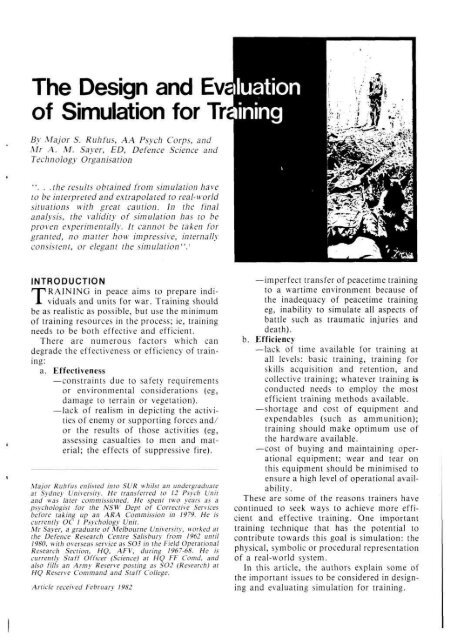ISSUE 34 : May/Jun - 1982 - Australian Defence Force Journal
ISSUE 34 : May/Jun - 1982 - Australian Defence Force Journal
ISSUE 34 : May/Jun - 1982 - Australian Defence Force Journal
You also want an ePaper? Increase the reach of your titles
YUMPU automatically turns print PDFs into web optimized ePapers that Google loves.
The Design and Ev«<br />
of Simulation for Tr<br />
By Major S. Ruhfus, AA Psych Corps, and<br />
Mr A. M. Saver. ED, <strong>Defence</strong> Science and<br />
Technology Organisation<br />
". . .the results obtained from simulation have<br />
to be interpreted and extrapolated to real-world<br />
situations with great caution. In the final<br />
analysis, the validity of simulation has to be<br />
proven experimentally. It cannot be taken for<br />
granted, no matter how impressive, internally<br />
consistent, or elegant the simulation".'<br />
INTRODUCTION<br />
TRAINING in peace aims to prepare individuals<br />
and units for war. Training should<br />
be as realistic as possible, but use the minimum<br />
of training resources in the process; ie, training<br />
needs to be both effective and efficient.<br />
There are numerous factors which can<br />
degrade the effectiveness or efficiency of training:<br />
a. Effectiveness<br />
—constraints due to safety requirements<br />
or environmental considerations (eg,<br />
damage to terrain or vegetation).<br />
—lack of realism in depicting the activities<br />
of enemy or supporting forces and/<br />
or the results of those activities (eg,<br />
assessing casualties to men and material;<br />
the effects of suppressive fire).<br />
Major Ruhfus enlisted into SUR whilst an undergraduate<br />
at Sydney University. He transferred to 12 Psych Unit<br />
and was later commissioned. He spent two years as a<br />
psychologist for the NSW Dept of Corrective Services<br />
before taking up an ARA Commission in 1979. He is<br />
currently OC I Psychology Unit.<br />
Mr Saver, a graduate of Melbourne University, worked at<br />
the <strong>Defence</strong> Research Centre Salisbury from 1962 until<br />
1980, with overseas service as S03 in the Field Operational<br />
Research Section, HO, AFV, during 1967-68. He is<br />
currently Staff Officer (Science) at HQ FF Comd, and<br />
also fills an Army Reserve posting as S02 (Research) at<br />
HQ Reserve Command and Staff College.<br />
Article received February <strong>1982</strong><br />
— imperfect transfer of peacetime training<br />
to a wartime environment because of<br />
the inadequacy of peacetime training<br />
eg, inability to simulate all aspects of<br />
battle such as traumatic injuries and<br />
death).<br />
b. Efficiency<br />
— lack of time available for training at<br />
all levels: basic training, training for<br />
skills acquisition and retention, and<br />
collective training; whatever training is<br />
conducted needs to employ the most<br />
efficient training methods available.<br />
— shortage and cost of equipment and<br />
expendables (such as ammunition);<br />
training should make optimum use of<br />
the hardware available.<br />
—cost of buying and maintaining operational<br />
equipment; wear and tear on<br />
this equipment should be minimised to<br />
ensure a high level of operational availability.<br />
These are some of the reasons trainers have<br />
continued to seek ways to achieve more efficient<br />
and effective training. One important<br />
training technique that has the potential to<br />
contribute towards this goal is simulation: the<br />
physical, symbolic or procedural representation<br />
of a real-world system.<br />
In this article, the authors explain some of<br />
the important issues to be considered in designing<br />
and evaluating simulation for training.

















